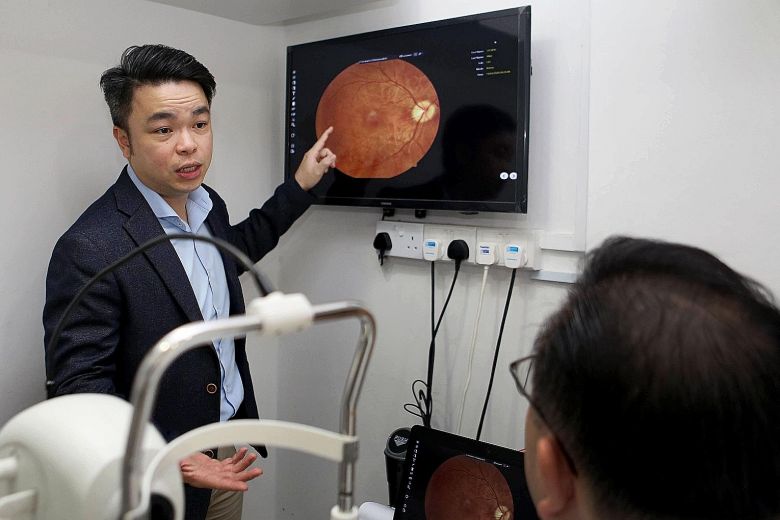
Singapore
Optometric Association president Ken Tong analysing the image of a patient's
retina on AI system Selena+. The system can tell from the photo of a person's
eye whether he has diabetic retinopathy, glaucoma or age-related macular
degeneration with a greater than 90 per cent accuracy. ST PHOTO: JOEL CHAN
CE
mark for system developed here set to facilitate its acceptance in overseas
markets
A tool developed here that takes less than two minutes to tell if a person has a major eye problem has just been approved for sale in Europe.
The system, developed jointly by the Singapore Eye Research Institute (Seri) and the School of Computing at the National University of Singapore (NUS), can tell from a photograph of the person's eye whether he has diabetic retinopathy, glaucoma or age-related macular degeneration with a greater than 90 per cent accuracy.
This is equal to or even better than the results of human graders, and done very much faster.
These three eye conditions are major problems that seniors face that could lead to blindness if left untreated.
The Singapore Eye Lesion Analyser Plus, or Selena+, was first mentioned by Deputy Prime Minister and Minister for Finance Heng Swee Keat last November when he said the system "can be applied beyond Singapore, to the region and the world".
Health Minister Gan Kim Yong also told Parliament during the debate on his ministry's budget that there are plans to "leverage technologies such as artificial intelligence, machine learning and robotics to support the work in public healthcare".
Selena+ is a deep-learning artificial intelligence software system that has proven to be more efficient in delivering fast and accurate results, he said.
Mr Gan noted that it "highlights areas with potential vision-threatening eye disease and refers abnormal cases to human graders, allowing them to focus on the more complex cases".
SingHealth, one of the three public healthcare clusters in Singapore, holds the licence on behalf of Seri and NUS. It has licensed it to local start-up EyRIS, which obtained the European Union approval, known as a CE mark.
The system was approved for use in Singapore by the Health Sciences Authority last October.
EyRIS chief executive Lai Teik Kin said the CE mark is internationally recognised and will make it easier for the product to be accepted in other countries. The start-up hopes to see the system also used in the Middle East and Australia.
About half a million eye images of people from different ethnic backgrounds were used to develop the algorithm for the software, which took about a decade to produce and fine-tune.
Seri chairman Wong Tien Yin, who was very much involved in developing Selena+, called the CE mark an important validation that "will now allow a Singapore company to provide this product in Europe".
EyRIS signed a memorandum of understanding with the Singapore Optometric Association (SOA) last Thursday on the use of Selena+.
Professor Wong said: "The partnership between EyRIS and SOA will provide even wider access to primary eye care for Singaporeans."
SOA president Ken Tong said optometrists using Selena+ "can play a vital role in eradicating eye problems" by screening customers for problems so that they can get them treated early.
The development of Selena+ does not end here. Mr Gan said more research is taking place to turn it into a tool that can predict the risk of cardiovascular disease.
This would "help doctors accurately identify high-risk patients and conduct more timely interventions to save lives and achieve better outcomes".
Dr Gavin Tan, head of ocular imaging at the Singapore National Eye Centre, who is also involved in the project, said this is possible because you can see the blood vessels in the eye and detect changes in them cause by certain diseases.













 Get it on Google Play
Get it on Google Play